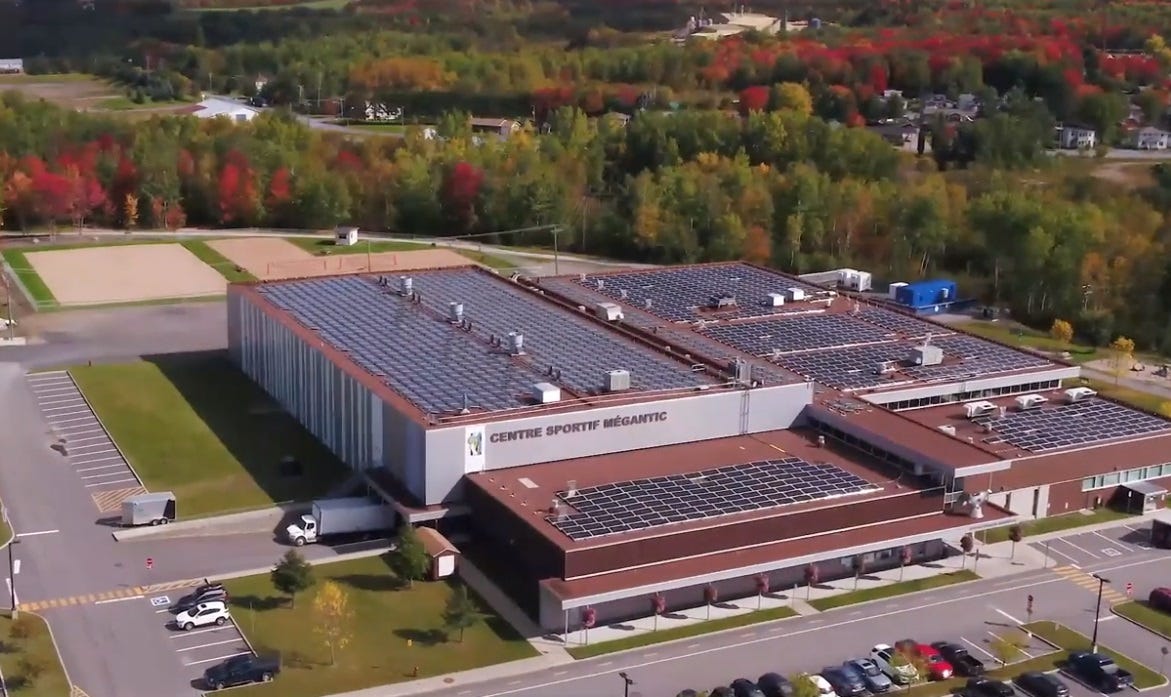After 2013 Oil Train Explosion, Canadian Town Rebuilt Clean And Green
My God, it's full of sun.

You might remember the news about the horrifying explosion and fire in 2013 that destroyed much of the small town of Lac-Mégantic, Québec. An unattended freight train rolled down a long hill into the town, reaching speeds around 60 miles per hour before it jumped the tracks and blew up. The explosion and fire killed 47 of the town’s roughly 6,000 residents, and wiped out much of the downtown, as well as many homes.
Rachel Maddow often mentioned the Lac-Mégantic disaster as the worst of many examples of what she called “bomb trains,” long trains of tank cars carrying crude oil all over North America and occasionally exploding when they derailed. President Barack Obama responded with a proposal for improved safety regulations, which after heavy industry lobbying was eventually adopted in watered-down form. (February’s toxic derailment in East Palestine, Ohio, says hello, and yes that was only this year.)
But you may have noticed that we’re calling this a Nice Time story, and it is: In the decade since the disaster, Lac-Mégantic has rebuilt itself — with lots of help from the Canadian government and from Hydro-Québec, the regional utility — with a first-in-Canada solar microgrid whose first phase came online in 2021 and can power about 30 of the town’s downtown buildings. Now, the government and Hydro-Québec have dedicated another $3.7 million to expand the microgrid to more parts of the community. (That’s about $2.69 million in real American poutine-free money.) The goal is to provide a model to other communities for how to transition to clean power, and as Microgrid Knowledge explains, Lac-Mégantic has enough stuff for a feller to have pretty good geek-out.
[The] Lac-Mégantic microgrid includes more than 2,200 solar panels generating 800 kW of power, 700 kW of battery energy storage, a centralized control system, energy management tools and a bidirectional electric vehicle charging station.
The microgrid is capable of islanding, or disconnecting and operating independently of Hydro-Québec’s main power grid, should there be a grid outage. Conversely, it allows the utility to integrate distributed energy resources into its grid.
Here’s a pretty neat video from Hydro-Québec last year, touting the features of the microgrid, which is ready for future expansions that will keep up with the town’s energy needs. (I liked the video even more when, a few minutes into it, I thought to turn on the English subtitles.)
And yeah, because I am now old enough to cry at everything, I teared up just a little at the detail about how the downtown’s new memorial pavilion is lit all night by clean power.
A fact sheet from Natural Resources Canada, the Canadian government’s energy, climate, and natural resources agency, says the new funding will go to building more infrastructure, including a “a state-of-the-art building with affordable units equipped with energy-efficient technologies,” which OMG can America do that in many cities in our next climate bill, please?
Other funding will go to educational materials on climate and the energy transition, to be used in schools, as well as programs to connect students in local schools with kids from indigenous communities to “create cultural connections and to exchange knowledge on the energy transition and the technologies that will help Canada achieve it.” And probably some rightwing dork will call that “indoctrination,” but screw it, this is a Nice Time. Lac-Mégantic will also serve as an information hub for other communities looking to transition to clean power, as Mayor Julie Morin said in the statement:
“Since a train full of fossil fuels destroyed downtown Lac-Mégantic, the community has turned to renewable energy and is increasingly recognized as a leader in energy transition in the municipal sector. Quebec's first neighbourhood-wide microgrid was built in the new downtown area, and now we want to go even further.
“The funding we received will make it possible, among other things, to develop a governance model that is mobilizing, sustainable and, above all, replicable for other communities. Thus, the knowledge gained concerning the adoption of technologies by the population, the importance given to the role of the community in the transition and the participatory governance model being implemented will all serve as an inspiration for other rural communities that will also wish to engage in the social and energy transition that involves everyone doing their part."
Oh golly, if that’s some kind of green socialism, then let’s please go to there too. The climate crisis is huge, but with efforts ranging from the community level to national policy, to scads of cool new energy tech, I’m becoming more and more convinced that, even starting thirty years too late, we’re going to tackle it. Not that it’ll be easy, but there are so many exciting developments out there, and smart people working on all of it, that I’m feeling a lot more hopeful than in the last couple decades.
[Energy Mix / Lac-Mégantic Microgrid at Hydro-Québec / Microgrid Knowledge / Wired]
Yr Wonkette is funded entirely by reader donations. If you can, please subscribe, or if a one-time donation — a microdonation, even — would help charge your batteries, here’s the button you need.






OT: A bit o' cheer...
𝗨𝗦 𝗦𝗲𝗻𝗮𝘁𝗲 𝗰𝗶𝗿𝗰𝘂𝗺𝘃𝗲𝗻𝘁𝘀 𝗧𝘂𝗯𝗲𝗿𝘃𝗶𝗹𝗹𝗲 𝗵𝗼𝗹𝗱𝘀 𝗮𝗻𝗱 𝗰𝗼𝗻𝗳𝗶𝗿𝗺𝘀 𝗻𝗲𝘄 𝗔𝗶𝗿 𝗙𝗼𝗿𝗰𝗲 𝗵𝗲𝗮𝗱, 𝗳𝗶𝗿𝘀𝘁 𝗳𝗲𝗺𝗮𝗹𝗲 𝗼𝗻 𝗝𝗼𝗶𝗻𝘁 𝗖𝗵𝗶𝗲𝗳𝘀
https://apnews.com/article/military-nominations-senate-tuberville-holds-0c3a5441fb94887fdb0e1b1b65a399f5
There goes Canada again, proving you can have nice things if you’re not gerrymandered by Republicans with oil money stuck up their ass.